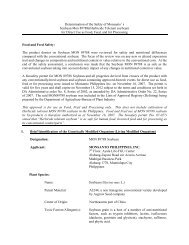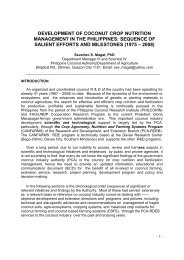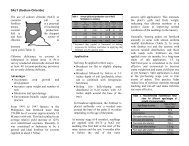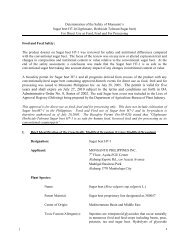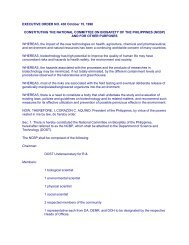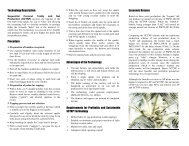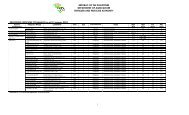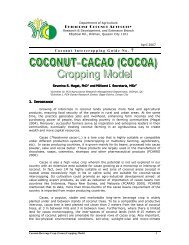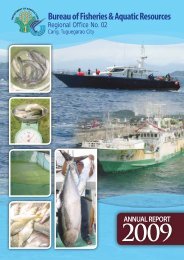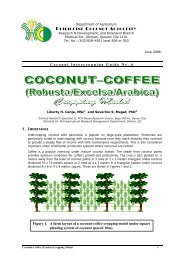Department of Agriculture - Philippine Coconut Authority ...
Department of Agriculture - Philippine Coconut Authority ...
Department of Agriculture - Philippine Coconut Authority ...
- No tags were found...
Create successful ePaper yourself
Turn your PDF publications into a flip-book with our unique Google optimized e-Paper software.
While wholesale prices showed minimal fluctuations during the same period. The<strong>Philippine</strong>s has not imported any sweet potato during the last five years. Volume<strong>of</strong> exports had increased from a low <strong>of</strong> 116 kg in 1999 up to 950 kg in 2003.3.3 Ubi (Dioscorea alata) and Tugui (Dioscorea esculenta) are the two mostimportant yam varieties commonly cultivated in the <strong>Philippine</strong>s. They arecultivated in small patches <strong>of</strong> land, <strong>of</strong>tentimes less than a hectare, particularly insome regions <strong>of</strong> the <strong>Philippine</strong>s as Ilocos, Southern Tagalog, Bicol, CentralVisayas and Northern Mindanao. Recently, the commercial potential <strong>of</strong> ubi (D.alata Linn.) has been recognized in the country despite its being a minorcommodity (http://www.pcarrd.dost.ph/division/acd/ or PCARRD Ubi IndustrySituationer, 1998). Ubi is a promising and high value crop because <strong>of</strong> its growingdemand in the industry food sector in both local and export markets.3.4 Gabi (Taro) – is one <strong>of</strong> the most important root crops in the <strong>Philippine</strong>s(http://vicarp.lsu-visca.edu.p/technologies.htm). The <strong>Philippine</strong>s has the largestarea devoted to taro in Asia proper, apart from China(http:www.fao.org/docrep/005/ac450e/ac450e08.htm). In 1996, about 34,000hectares <strong>of</strong> land were devoted to taro, producing tuber root yields <strong>of</strong> about117,000 tons (FAO, 1997). Still taro is relatively a minor crop in the <strong>Philippine</strong>s.The food basket is dominated by rice and corn, with root crops as a group cominglower in the order. However, since about the mid-1990’s, a taro export trade hasgrown up in the <strong>Philippine</strong>s. The export goes mainly to New Zealand and themain operator for now is the DOLE International Company(http://www.fao.org//docrep/005/ac450e/ac450e08.htm). Many taro researcheshave been conducted at the Phil. Root Crop and Training Center (PRCTC) inBaybay, Leyte (Central <strong>Philippine</strong>s) based at the Leyte State University Campus(former Visayas State College <strong>of</strong> <strong>Agriculture</strong>).3.5 Ginger (Zingiber <strong>of</strong>ficinale, Rosc) is an important spice crop (mainlyharvested for the fresh mature roots) used in cooking, and preparing dishes andpreserves, candies and pickled food. It is a raw material in the production <strong>of</strong>beverage, perfumes and medicines although considered as a minor crop in the<strong>Philippine</strong>s. It is one <strong>of</strong> the country’s potential high – earning export crop.However, the national average yield is not highly impressive. So far, Farmers’limited knowledge about proper culture and management plus lack <strong>of</strong> knowledgefor ginger process have largely hindered the industry development((http://www.pcarrd.dost.ph/division/acd/ or PCARRD Ginger IndustrySituationer, 1981).4. GROWING CONDITIONS AND THE TECHNOLOGY4.1 Environmental RequirementsTo optimize the achievable yield <strong>of</strong> root crops under the coconut-root cropcropping system, it is essential to provide the suitable conditions (climate andsoils) for the two crops. Moreover, the competition for light, soil and waterresources usually results in marginal economic returns from one <strong>of</strong> thecomponent crops or in both.<strong>Coconut</strong>-Root Crops Cropping Model 6



